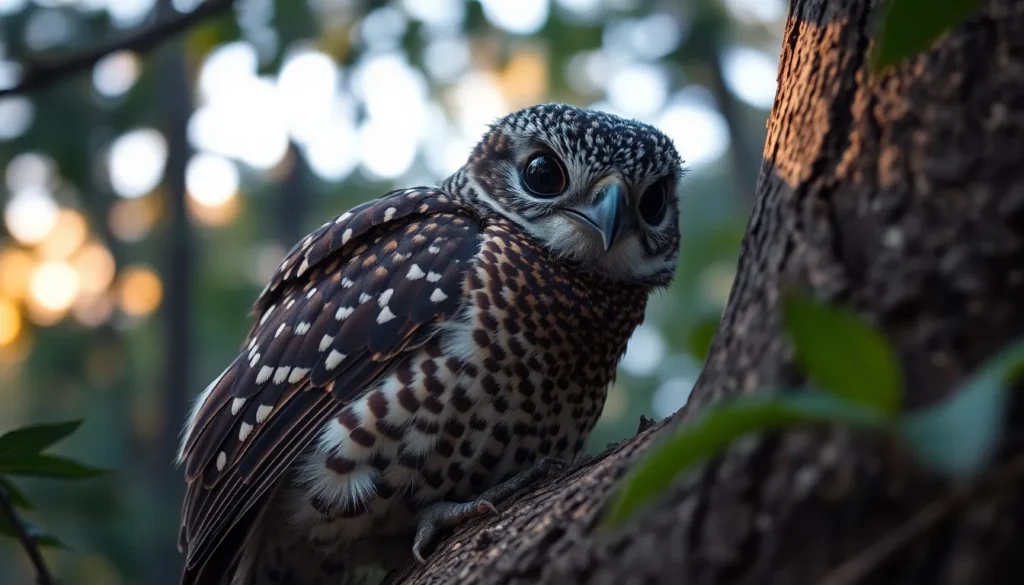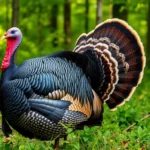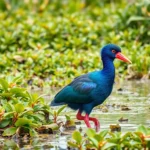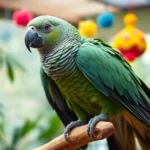Ever wondered about those mysterious birds that come alive when darkness falls? Nightjars are among nature’s most fascinating nocturnal creatures, yet they remain largely unknown to many bird enthusiasts. These remarkable birds have mastered the art of camouflage so well that you might walk right past one without ever knowing it was there.
We’re talking about birds that can practically disappear against tree bark during the day and transform into aerial acrobats at night. With their enormous mouths perfectly designed for catching insects mid-flight and their haunting calls that echo through twilight hours, nightjars represent one of the most specialized groups in the avian industry.
From their incredible camouflage abilities to their unique parenting strategies, we’ll explore everything that makes nightjars so captivating. Whether you’re a seasoned birder or simply curious about these elusive creatures, you’re about to discover why nightjars deserve a spot on every nature lover’s must-see list.
What Is a Nightjar Bird
Nightjars belong to the Caprimulgidae family, a diverse group of nocturnal birds comprising over 100 species worldwide. These medium-sized birds measure between 6 to 16 inches in length and possess distinctive physical characteristics that make them exceptional night hunters.
Most nightjar species display mottled brown, gray, and black plumage patterns that provide perfect camouflage against tree bark, leaf litter, and rocky surfaces during daylight hours. Their cryptic coloration makes them virtually invisible when resting motionless on the ground or perched lengthwise on branches.
Large mouths equipped with bristle-like feathers called rictal bristles help nightjars capture flying insects with remarkable precision. These specialized mouth structures can open extremely wide, creating an effective insect-catching net during flight. Their gape extends well beyond their small beaks, giving them a funnel-shaped opening for aerial feeding.
Nightjar eyes are proportionally large and positioned forward on their heads, providing excellent night vision and depth perception for handling in darkness. Short legs and weak feet reflect their ground-dwelling lifestyle, as they rarely perch upright like other bird species.
We find nightjars across every continent except Antarctica, with species adapted to diverse habitats including forests, woodlands, scrublands, and desert regions. Common nighthawk, whip-poor-will, and European nightjar represent some of the most recognizable species within this fascinating bird family.
Their distinctive vocalizations range from repetitive calls like the whip-poor-will’s namesake sound to churring trills and clicking noises that echo through the night. Males typically produce these calls to establish territory and attract mates during breeding season.
Physical Characteristics of Nightjar Birds
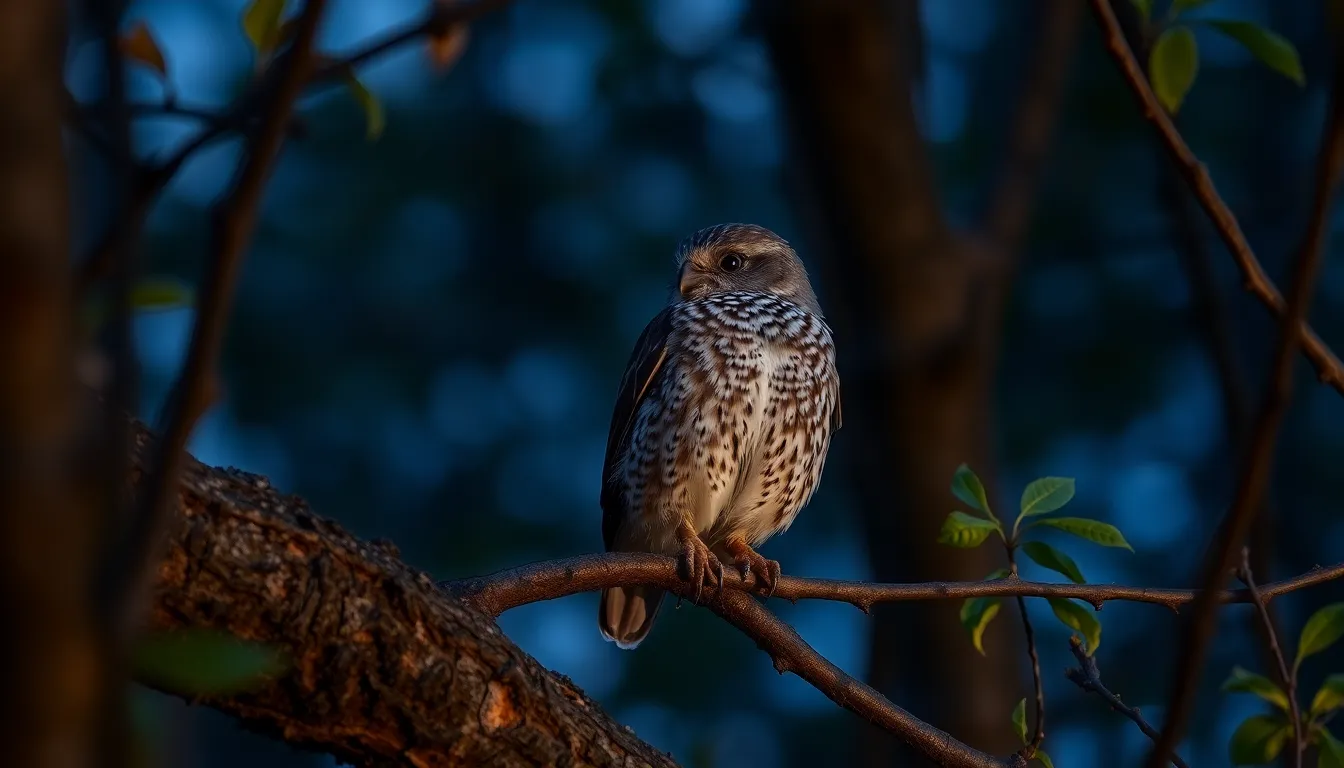
Nightjar birds possess remarkable physical adaptations that make them masterful nocturnal hunters. Their specialized anatomical features enable extraordinary camouflage abilities and precise insect capture techniques.
Size and Body Structure
Nightjar species demonstrate considerable size variation across their 100+ member family. Common nighthawks measure 8.5 to 9.5 inches in length with wingspans reaching 22 to 24 inches. European nightjars typically span 10 to 11 inches in body length while maintaining compact proportions. Whip-poor-wills average 9 to 10 inches from bill to tail with streamlined builds optimized for agile flight patterns.
Their bodies feature short necks that compress during daylight roosting positions. Nightjar legs remain notably short and weak compared to other bird species since ground walking plays minimal roles in their survival strategies. Wing structures appear long and pointed in most species, creating efficient flight dynamics for sustained aerial hunting sessions. Body proportions favor lightweight frames that support extended nocturnal activity periods without excessive energy expenditure.
Distinctive Plumage and Camouflage
Nightjar plumage patterns create exceptional camouflage through intricate feather colorations. Brown and gray base colors dominate their feather schemes, interrupted by black streaks and buff markings that mimic tree bark textures. Mottled patterns vary significantly between species but consistently replicate woodland debris appearances.
Male nightjars often display white patches on wing tips and tail corners that become visible during flight displays. Chuck-will’s-widow males showcase prominent white throat patches, while females maintain subdued brown throat coloring. Feather textures appear soft and loose, reducing noise production during flight and improving stealth capabilities. Cryptic coloration extends across their entire body surface, including crown feathers that blend seamlessly with surrounding vegetation when birds assume horizontal roosting positions.
Unique Mouth and Wing Features
Nightjar mouths represent their most specialized hunting adaptation through exceptionally wide gape openings. Their bills appear small and narrow when closed but expand dramatically during feeding to create funnel-like openings. Rictal bristles extend from bill bases, functioning as insect detection sensors that guide prey capture accuracy.
Wing structures incorporate flexible flight feathers that enable silent flight patterns essential for hunting success. Primary feathers feature soft leading edges that minimize air turbulence and eliminate wing beat sounds. Wing loading remains low across nightjar species, allowing rapid directional changes during insect pursuit sequences. Flight membranes extend between their toes on some species, creating additional surface area for aerial maneuverability during complex hunting behaviors.
Nightjar Bird Species Around the World
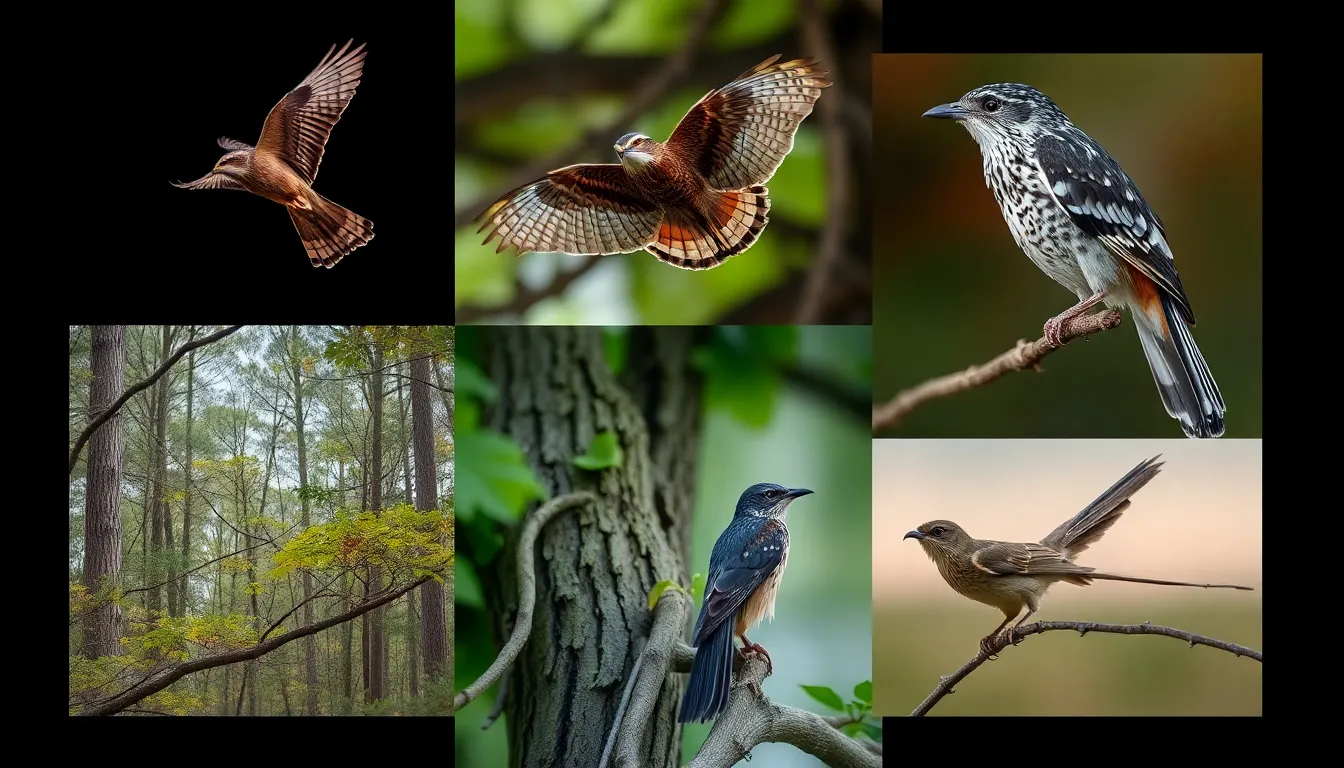
Nightjar species populate diverse environments across six continents, with each region hosting unique varieties adapted to local conditions. Our exploration covers the most notable species from North America to tropical regions.
Common Nightjar Species in North America
Common nighthawks (Chordeiles minor) represent the most widespread nightjar species across North America, ranging from southern Canada to Central America. These birds measure 8.5 to 9.5 inches in length and display distinctive white patches on their wings during flight. Chuck-will’s-widows (Antrostomus carolinensis) inhabit southeastern United States forests and produce their characteristic three-note call throughout warm months.
Whip-poor-wills (Antrostomus vociferus) occupy eastern North American woodlands and deliver their repetitive namesake call up to 1,000 times consecutively during breeding season. Lesser nighthawks (Chordeiles acutipennis) prefer southwestern desert regions and display more pointed wings compared to their common nighthawk relatives. Common poorwills (Phalaenoptilus nuttallii) inhabit western mountain regions and hold the distinction of being the only bird species known to enter true hibernation.
European and Asian Nightjar Varieties
European nightjars (Caprimulgus europaeus) span from Western Europe to Central Asia, measuring 10 to 11 inches with intricate bark-like plumage patterns. Large-tailed nightjars (Caprimulgus macrurus) inhabit Southeast Asian forests and feature exceptionally long tail feathers that aid in aerial maneuvers. Red-necked nightjars (Caprimulgus ruficollis) occupy southwestern Europe and North Africa, displaying distinctive rufous collar markings.
Egyptian nightjars (Caprimulgus aegyptius) prefer arid regions from North Africa to Central Asia and showcase pale, sandy-colored plumage for desert camouflage. Indian nightjars (Caprimulgus asiaticus) range across the Indian subcontinent and exhibit sexually dimorphic tail patterns with males showing prominent white spots.
Tropical and Southern Hemisphere Species
Long-tailed nightjars (Caprimulgus climacurus) inhabit African savannas and display remarkable tail streamers extending up to 24 inches in males during breeding season. Australian owlet-nightjars (Aegotheles cristatus) represent a unique family branch, measuring only 8 inches and occupying tree hollows unlike ground-nesting relatives. Lyre-tailed nightjars (Uropsalis lyra) soar through South American cloud forests with spectacular tail feathers reaching 30 inches in length.
Band-winged nightjars (Caprimulgus longirostris) populate Central and South American highlands, featuring distinctive wing bands visible during flight displays. Standard-winged nightjars (Caprimulgus longipennis) breed in African woodland savannas and males develop extraordinary wing plumes with paddle-shaped tips during mating season. Pennant-winged nightjars (Caprimulgus vexillarius) migrate across sub-Saharan Africa, with breeding males sporting ribbon-like wing extensions measuring up to 24 inches.
Habitat and Distribution
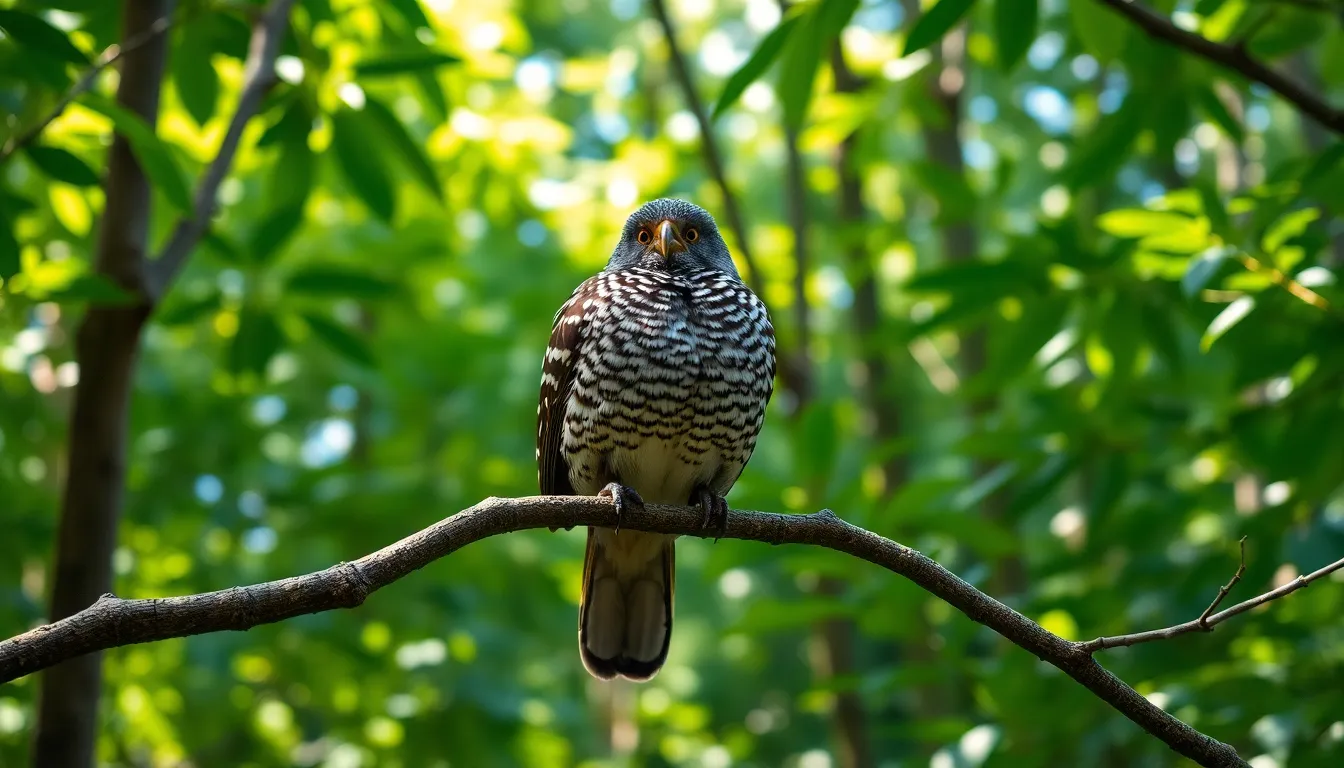
Nightjars demonstrate remarkable adaptability across virtually every terrestrial habitat on Earth except Antarctica. These nocturnal birds thrive in diverse environments ranging from dense tropical rainforests to arid desert landscapes. We find nightjar species occupying six major continents with over 100 species distributed globally.
Primary Habitat Types:
| Habitat Type | Species Examples | Geographic Regions |
|---|---|---|
| Temperate Forests | European Nightjar, Whip-poor-will | Europe, Eastern North America |
| Desert Regions | Lesser Nighthawk, Common Poorwill | Southwestern United States, Mexico |
| Tropical Rainforests | Long-tailed Nightjar, Standard-winged Nightjar | Central America, Southeast Asia, Africa |
| Grasslands | Common Nighthawk, Savanna Nightjar | Great Plains, African Savannas |
| Scrublands | Chuck-will’s-widow, Red-necked Nightjar | Southeastern United States, Mediterranean |
| Mountain Regions | Large-tailed Nightjar, Himalayan Nightjar | Asian Highlands, Andean Slopes |
Continental Distribution Patterns:
North American nightjar species concentrate heavily in the southeastern and southwestern regions. Common nighthawks breed across the entire continent from Alaska to Central America during summer months. Whip-poor-wills prefer deciduous and mixed forests from southeastern Canada through Central America. Chuck-will’s-widows inhabit pine forests and oak woodlands across the southeastern United States.
European populations center around the Mediterranean basin and extend northward into Scandinavia. European nightjars favor heathlands, moorlands, and open woodlands with sandy soils. Red-necked nightjars occupy the Iberian Peninsula and extend into North Africa during winter migrations.
Asian nightjar diversity peaks in Southeast Asia with over 30 species recorded. Large-tailed nightjars range from the Himalayas through Indonesia and the Philippines. Savanna nightjars populate open grasslands from India to southern China and throughout Southeast Asia.
African nightjar populations span from the Sahel region through sub-Saharan Africa. Standard-winged nightjars inhabit savanna regions across West and Central Africa. Pennant-winged nightjars breed in eastern and southern African woodlands.
Australian and New Zealand populations include unique species like the Australian owlet-nightjar and New Zealand nightjar. Tawny frogmouths occupy eucalyptus forests and urban parks across Australia. Large-tailed nightjars extend into northern Australia from Southeast Asia.
Elevation and Climate Preferences:
Most nightjar species prefer elevations below 3,000 feet with moderate temperatures and adequate insect populations. Mountain species like the Himalayan nightjar adapt to altitudes exceeding 8,000 feet during breeding season. Desert dwelling species tolerate extreme temperature variations between 20°F and 120°F.
Tropical species maintain year-round territories while temperate zone nightjars migrate seasonally following insect abundance. Migration distances vary from 500 miles for short-distance migrants to over 5,000 miles for transcontinental species.
Nightjar Bird Behavior and Lifestyle

Nightjars exhibit fascinating behavioral patterns that showcase their remarkable adaptation to nocturnal life. These secretive birds demonstrate complex hunting strategies, territorial displays, and migration behaviors that make them some of nature’s most specialized avian predators.
Nocturnal Hunting Patterns
Nightjars begin their hunting activities approximately 30 minutes after sunset when insect activity peaks. Aerial insectivores like common nighthawks perform continuous flight patterns between 50 and 200 feet above ground, capturing moths, beetles, and flying ants with their wide-opening mouths. European nightjars employ a sit-and-wait strategy, perching on fence posts or dead branches before launching surprise attacks on passing prey.
Flight hunting techniques vary significantly among nightjar species based on their preferred habitats. Chuck-will’s-widows hunt within forest canopies using short bursts of flight between perches, while lesser nighthawks perform extended aerial maneuvers over open desert landscapes. Common poorwills demonstrate ground-level hunting behaviors, snatching insects directly from vegetation surfaces during low-altitude flights.
Peak hunting periods occur between 9 PM and 2 AM when moth populations reach maximum activity levels. Whip-poor-wills can capture up to 100 insects per hour during optimal hunting conditions, with individual prey items ranging from 3mm mosquitoes to 40mm sphinx moths. Large-tailed nightjars in Asia demonstrate remarkable precision, achieving hunting success rates exceeding 85% during moonlit nights.
Territorial and Mating Behaviors
Male nightjars establish territories averaging 2 to 15 acres depending on habitat quality and species type. Whip-poor-wills produce their distinctive calls up to 16,000 times per night during peak breeding season to defend territory boundaries and attract potential mates. European nightjars perform elaborate aerial displays, creating mechanical wing-clapping sounds that carry across distances exceeding 500 meters.
Courtship rituals among nightjar species involve complex visual and auditory demonstrations that occur between April and July in temperate regions. Common nighthawks execute dramatic diving displays, creating booming sounds through specialized wing feathers at speeds reaching 60 miles per hour. Chuck-will’s-widows present food offerings to females while producing continuous vocalizations that can last for 3 to 4 hours without interruption.
Nesting behaviors demonstrate remarkable site selection strategies optimized for camouflage and protection. Female nightjars create simple ground scrapes lined with leaves or pine needles, typically positioned beneath overhanging vegetation or fallen logs. Long-tailed nightjars in tropical regions synchronize their breeding cycles with rainy seasons when insect abundance reaches annual peaks, ensuring optimal feeding conditions for developing chicks.
Migration Patterns
Temperate zone nightjar species undertake extensive migrations covering distances between 2,000 and 8,000 miles annually. Common nighthawks breeding in Alaska travel to South American wintering grounds, crossing the Gulf of Mexico in single non-stop flights lasting 18 to 24 hours. European nightjars migrate from northern breeding territories to sub-Saharan Africa, following established flyways that coincide with peak insect emergence patterns.
Migration timing varies among nightjar populations based on geographic location and local climate conditions. North American species begin southward movements between late August and early October, while European populations start migration during September when insect availability begins declining. Whip-poor-wills from Canadian breeding grounds reach Central American destinations by November, spending 4 to 5 months in tropical wintering habitats.
Navigation strategies employed by migrating nightjars combine celestial orientation with magnetic field detection capabilities. Satellite tracking studies reveal that common nighthawks maintain consistent flight altitudes between 1,500 and 3,000 feet during migration, adjusting their routes to follow mountain ridges and river valleys that provide favorable wind conditions. Lesser nighthawks demonstrate remarkable site fidelity, returning to identical breeding territories with location accuracy within 100 meters after completing 4,000-mile round-trip migrations.
Diet and Feeding Habits
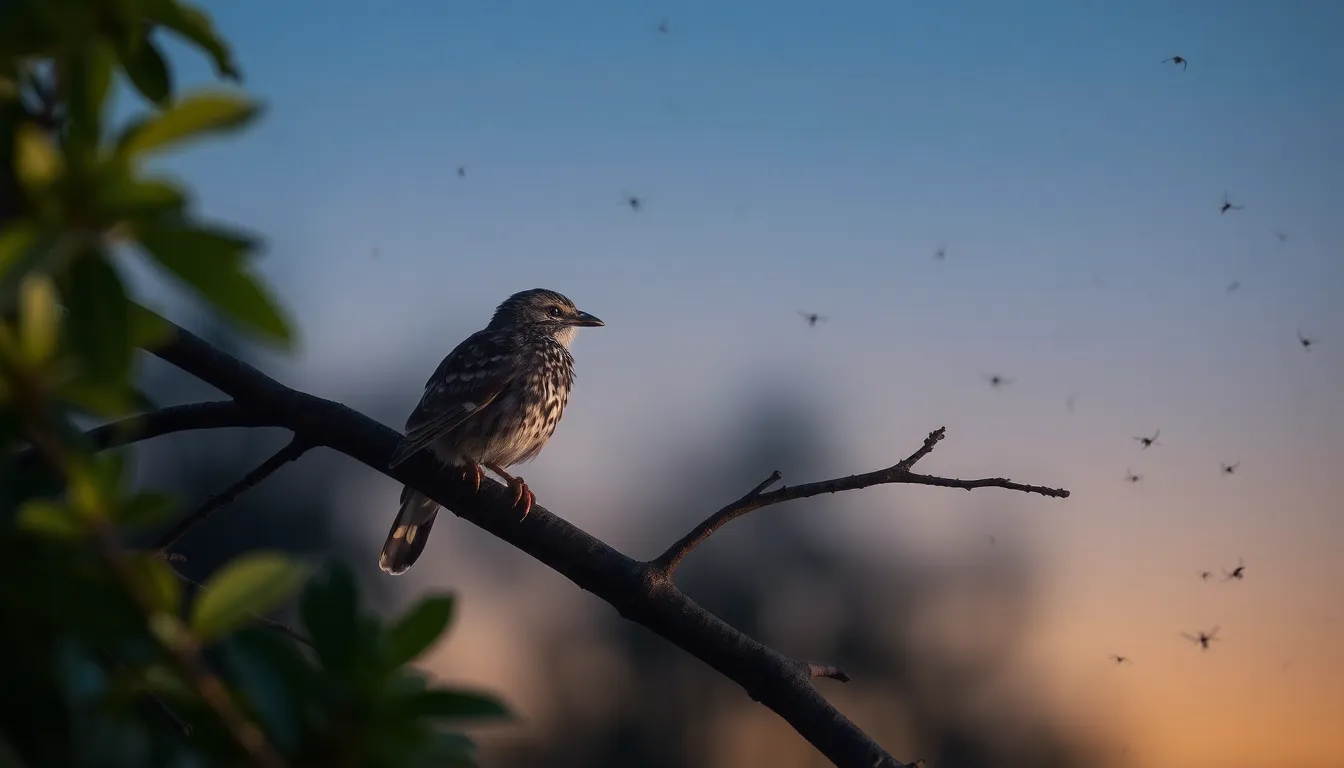
Nightjars are exclusively insectivorous birds that consume flying insects with remarkable efficiency during their nocturnal hunts. Their diet consists primarily of moths, beetles, flying ants, mosquitoes, and flying termites captured mid-flight using their specialized wide-opening mouths.
Primary Prey Species
Moths constitute approximately 60-70% of most nightjar species’ diet, making them the preferred food source during peak hunting hours. Flying beetles, particularly scarab beetles and cockchafers, provide substantial protein content during spring and early summer months. Mosquitoes and gnats become increasingly important food sources in wetland environments and during humid weather conditions.
| Prey Type | Percentage of Diet | Peak Availability | Hunting Method |
|---|---|---|---|
| Moths | 60-70% | Dusk to midnight | Aerial pursuit |
| Flying beetles | 15-20% | Spring/early summer | Sit-and-wait |
| Flying ants | 10-15% | Swarming seasons | Mass feeding |
| Mosquitoes | 5-10% | Humid evenings | Continuous flight |
Hunting Techniques and Feeding Behavior
European nightjars employ the sit-and-wait strategy, perching on exposed branches or fence posts while scanning for insect movement within a 50-foot radius. Common nighthawks demonstrate continuous aerial feeding patterns, opening their mouths wide while flying through insect swarms above open areas. Chuck-will’s-widows use low-level ground hunting techniques, capturing insects disturbed by their movement through vegetation.
Feeding Adaptations
Rictal bristles surrounding nightjar mouths function as sensory organs that detect insect presence and guide prey into their gaping mouths during high-speed chases. Their throat pouches expand considerably to accommodate large insects like sphinx moths, which can measure up to 4 inches in wingspan. Nightjars possess specialized stomach structures that efficiently process hard insect exoskeletons, including beetle wing covers and moth scales.
Seasonal Feeding Patterns
Spring feeding focuses heavily on emerging beetles and early-season moths as nightjars rebuild energy reserves after migration. Summer months provide peak insect diversity, allowing nightjars to consume up to 500 individual insects per night during optimal conditions. Autumn feeding intensifies as birds prepare for migration, with fat reserves increasing by 30-40% through concentrated insect consumption during September and October.
Breeding and Nesting
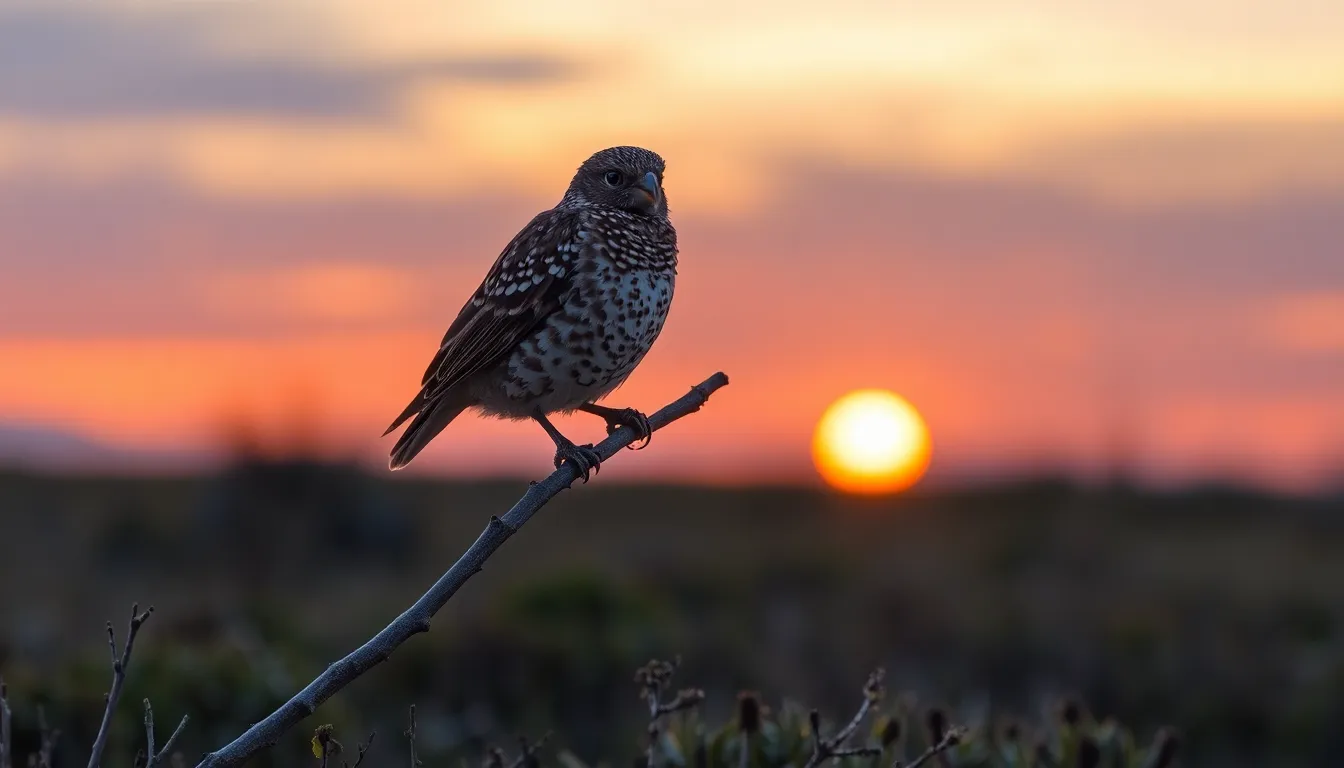
Nightjar breeding behaviors demonstrate remarkable adaptations to their nocturnal lifestyle and ground nesting preferences. These fascinating birds exhibit complex reproductive strategies that maximize their chances of successfully raising offspring in challenging environments.
Courtship Rituals and Displays
Males begin their elaborate courtship performances during late spring and early summer when territories become established. European nightjars execute spectacular aerial displays featuring wing clapping sounds created by striking their wings together above their backs. Common nighthawks dive from heights of 150 to 200 feet while producing distinctive booming sounds through specialized flight feathers.
Territorial males vocalize persistently from prominent perches during dusk hours to attract potential mates. Chuck will’s widows repeat their namesake call up to 400 times consecutively while positioned on fence posts or low branches. Whip poor wills deliver their three syllable song more than 1,000 times per hour during peak breeding season.
Ground based displays complement aerial performances as males spread their wings and fan their tails to showcase white markings. European nightjar males perform wing flicking movements while approaching females with their distinctive white wing patches prominently displayed. These courtship rituals typically continue for 2 to 3 weeks before successful pair bonding occurs.
Nesting Sites and Egg Laying
Nightjars create minimal nests directly on bare ground without any construction materials or structural support. Females select sites with excellent camouflage properties including leaf litter patches under shrubs or among fallen logs. European nightjars prefer locations on heathland with scattered vegetation cover approximately 12 to 18 inches high.
Most species lay exactly 2 eggs with cream or buff coloration featuring brown and gray speckles that blend seamlessly with surrounding substrate. Common nighthawks deposit their eggs on flat rooftops covered with gravel or on rocky cliff ledges. Desert dwelling lesser nighthawks choose sites near water sources within 500 yards of reliable insect foraging areas.
Egg laying occurs at 48 hour intervals with incubation beginning immediately after the second egg appears. Females handle primary incubation duties for 18 to 20 days while males provide territorial defense and occasional food deliveries. Chuck will’s widows and whip poor wills often relocate their eggs by carrying them in their mouths when disturbance threatens the original site.
Parental Care and Chick Development
Nightjar chicks hatch with thick down feathers and remain in the nest area for their first 16 to 20 days of life. Both parents participate in feeding duties by bringing insects directly to the chicks’ mouths during nighttime foraging trips. European nightjar parents make 200 to 300 feeding visits per night during peak chick rearing periods.
Young nightjars develop remarkable camouflage abilities within their first week and freeze motionless when predators approach. Parents use distraction displays including broken wing acts and vocal calls to lead threats away from vulnerable chicks. Common nighthawk adults perform aggressive dive bombing behaviors against intruders approaching within 50 yards of their offspring.
Fledgling nightjars begin making short flights at 17 to 21 days old but continue receiving parental care for an additional 2 to 3 weeks. Parents gradually reduce feeding frequency to encourage independent foraging behavior before the young birds disperse to establish their own territories. Many nightjar species produce second broods during favorable seasons with adequate insect abundance and suitable weather conditions.
Conservation Status and Threats
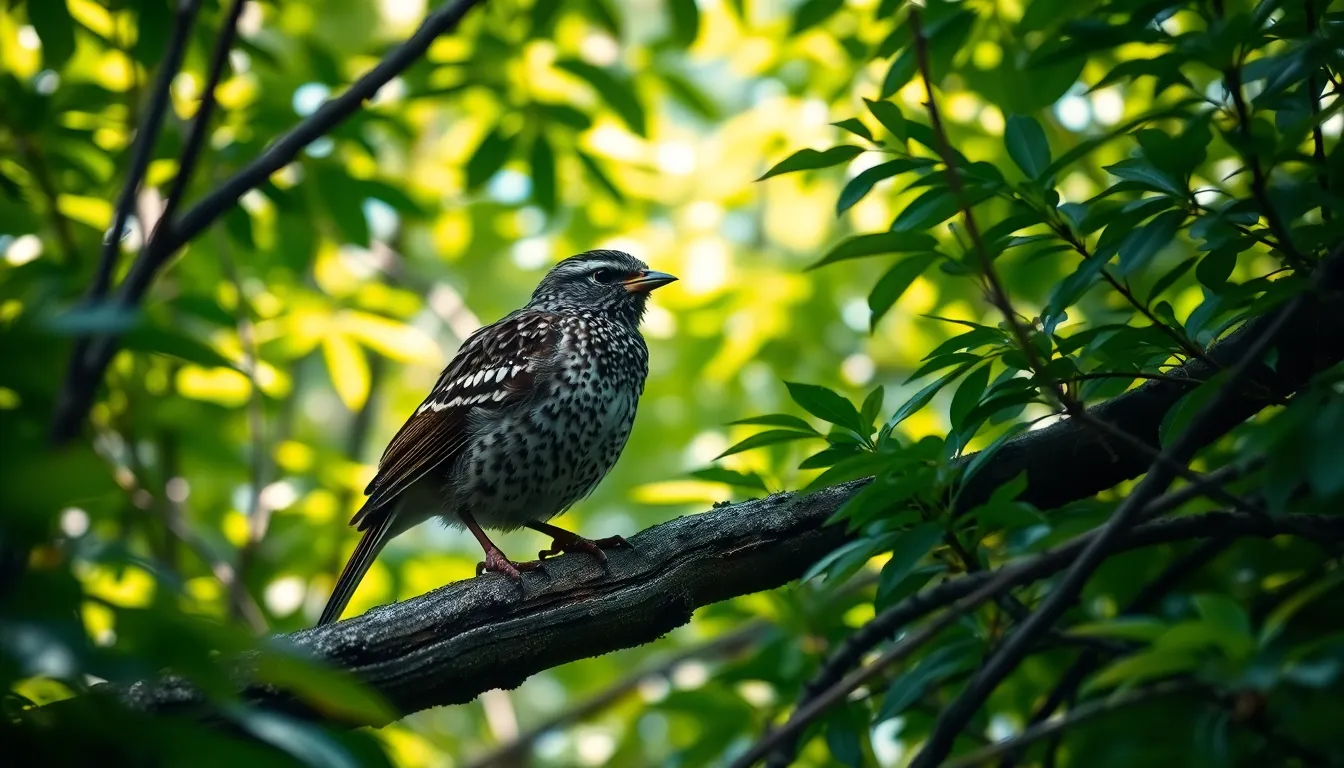
Nightjar populations face mounting pressures across their global range, with habitat destruction emerging as the most important conservation challenge. Urban development eliminates critical roosting and nesting areas that these ground-dwelling birds require for successful reproduction. Agricultural expansion fragments the continuous woodland habitats that nightjars depend on for establishing territories and hunting corridors.
Climate change disrupts the delicate timing between nightjar migration patterns and insect emergence cycles. Rising temperatures shift insect populations to higher latitudes and elevations, forcing nightjars to expend additional energy traveling to locate adequate food sources. Extreme weather events during migration periods increase mortality rates, particularly affecting long-distance migrants like whip-poor-wills that travel from Canada to Central America.
Light pollution creates substantial obstacles for nightjar survival by disrupting their natural hunting behaviors. Artificial lighting attracts and depletes the moth populations that comprise 60-70% of their diet. Urban streetlights and commercial lighting systems alter nightjar circadian rhythms, reducing their hunting effectiveness during peak activity hours between 9 PM and 2 AM.
| Species | Conservation Status | Primary Threats | Population Trend |
|---|---|---|---|
| European Nightjar | Least Concern | Habitat loss, forestry practices | Stable |
| Chuck-will’s-widow | Near Threatened | Deforestation, climate change | Declining |
| Whip-poor-will | Near Threatened | Forest fragmentation, pesticides | Declining |
| Egyptian Nightjar | Vulnerable | Desert degradation, human disturbance | Declining |
| White-winged Nightjar | Endangered | Mining, grazing pressure | Critically low |
Pesticide use eliminates the insect prey base that sustains nightjar populations throughout their breeding season. Chemical treatments reduce moth abundance by up to 80% in treated agricultural areas. Bioaccumulation of toxins in nightjar tissues affects reproduction success rates, with contaminated adults producing thinner eggshells and experiencing reduced fertility.
Forest management practices disrupt the exact microhabitats that nightjars require for nesting success. Clear-cutting operations remove the leaf litter and ground cover that provides camouflage for eggs and chicks. Intensive forestry rotations prevent the development of mature woodland edges where nightjars establish prime hunting territories.
Wind turbine installations pose emerging threats to nightjar populations along established migration routes. Collision mortality increases during peak migration periods when nightjars fly at turbine blade heights. Acoustic impacts from turbine operations interfere with male territorial calls and courtship vocalizations essential for breeding success.
Human recreation activities in natural areas disturb nightjar roosting sites during critical daylight hours. Off-road vehicle traffic compacts soil and eliminates ground vegetation that nightjars use for nesting concealment. Increased foot traffic during breeding season causes nest abandonment rates to rise significantly in popular outdoor recreation areas.
Research indicates that nightjar species adapted to exact habitat types face higher extinction risks than generalist species. Mountain specialists like the Himalayan nightjar encounter habitat loss through warming temperatures that push suitable conditions to increasingly higher elevations. Desert-adapted species experience range contractions as arid regions become more extreme due to changing precipitation patterns.
How to Spot and Identify Nightjar Birds

Spotting nightjars requires understanding their nocturnal habits and exceptional camouflage abilities. We’ve compiled proven strategies to help birders successfully locate and identify these elusive species.
Best Times and Locations for Observation
Peak Activity Windows
Nightjars become active approximately 30 minutes after sunset when light levels drop to optimal hunting conditions. We recommend arriving at observation sites during the golden hour before sunset to position yourself strategically. Prime viewing occurs between 9 PM and 2 AM when nightjars engage in their most intensive feeding behaviors.
Dawn Activity Patterns
Morning observations prove equally productive during the hour before sunrise when nightjars complete their final hunting rounds. European nightjars often perch on fence posts and low branches during these twilight periods. Common nighthawks remain airborne longer than ground dwelling species like whip poor wills.
Seasonal Timing Considerations
| Species | Best Observation Months | Peak Vocalization Period |
|---|---|---|
| Common Nighthawk | May – September | June – July |
| Whip-poor-will | April – August | May – June |
| European Nightjar | May – September | June – July |
| Chuck-will’s-widow | March – October | April – June |
Optimal Habitat Locations
Forest edges provide the highest success rates for nightjar observation as these areas combine hunting grounds with roosting sites. Open woodlands with scattered clearings attract species like common poorwills and lesser nighthawks. Desert scrublands support specialized species including lesser nighthawks in southwestern regions.
Grassland margins adjacent to wooded areas concentrate multiple nightjar species during migration periods. Mountain clearings below 3000 feet elevation offer opportunities to observe highland adapted populations. Riparian corridors serve as migration highways where various species converge during spring and fall movements.
Field Identification Tips
Physical Characteristics Recognition
Size comparison provides the first identification clue with common nighthawks measuring 8.5 to 9.5 inches while European nightjars average 10 to 11 inches in length. Wing shape distinguishes species during flight observations as common nighthawks display distinctive white patches on their long pointed wings. Chuck will widows exhibit rounded wing tips compared to the angular profiles of whip poor wills.
Plumage Pattern Analysis
Mottled brown and gray patterns dominate nightjar plumage but subtle variations help separate similar species. Males often show prominent white throat patches and wing bars that become visible during territorial displays. European nightjars display distinctive white spots on wing tips and tail corners that flash conspicuously during flight.
Ground roosting birds position themselves parallel to tree branches to maximize their camouflage effectiveness. Bark mimicking patterns vary between species with some showing more pronounced streaking while others exhibit fine vermiculation patterns.
Behavioral Identification Markers
Flight patterns offer reliable species separation with common nighthawks performing erratic aerial maneuvers while European nightjars employ more direct flight paths. Perching preferences vary significantly as some species favor horizontal branches while others select vertical fence posts or rock outcroppings.
Vocalization Recognition
| Species | Primary Call | Repetition Pattern | Distance Audible |
|---|---|---|---|
| Whip-poor-will | “Whip-poor-will” | 100+ repetitions | 0.5 miles |
| Chuck-will’s-widow | “Chuck-will’s-widow” | 20-40 repetitions | 0.75 miles |
| Common Nighthawk | Nasal “peent” | Single calls | 0.25 miles |
| Common Poorwill | “Poor-will” | 10-30 repetitions | 0.3 miles |
Territorial calls begin approximately 30 minutes after sunset with males vocalizing from consistent perch locations. Recording playback can attract males during breeding season but we recommend using this technique sparingly to avoid disrupting natural behaviors. Wing clapping sounds during aerial displays help identify common nighthawks performing their characteristic diving courtship flights.
Conclusion
Nightjars represent some of nature’s most remarkable adaptations for nocturnal life. Their perfect camouflage silent flight and precision hunting make them truly exceptional birds that deserve our attention and protection.
We’ve explored how these aerial insectivores have mastered the art of surviving in darkness from their specialized anatomy to their complex behaviors. Each species brings unique characteristics that help them thrive in diverse environments worldwide.
The conservation challenges facing nightjar populations remind us that protecting these birds requires immediate action. By understanding their needs and supporting habitat preservation we can ensure future generations will experience the magic of hearing a whip-poor-will’s call on a summer evening.
Whether you’re a seasoned birder or nature enthusiast we encourage you to venture out after sunset and discover these incredible creatures for yourself. The industry of nightjars offers endless fascination for those willing to explore the mysteries of the night.
Frequently Asked Questions
What are nightjars and why are they hard to spot?
Nightjars are nocturnal birds from the Caprimulgidae family with over 100 species worldwide. They’re difficult to spot due to their exceptional camouflage abilities and mottled brown, gray, and black plumage that perfectly mimics tree bark and leaf litter. During the day, they remain motionless on the ground or perched lengthwise on branches, making them nearly invisible to observers.
What do nightjars eat and how do they hunt?
Nightjars are exclusively insectivorous, with moths comprising 60-70% of their diet. They also consume flying beetles, ants, and mosquitoes. They hunt using various techniques including sit-and-wait strategies and continuous aerial feeding. Their large mouths equipped with rictal bristles help detect and capture prey with remarkable precision during nighttime hunting sessions.
Where can nightjars be found around the world?
Nightjars inhabit every continent except Antarctica, adapting to diverse environments from tropical rainforests to arid deserts. They thrive in temperate forests, grasslands, scrublands, and mountain regions. Most species prefer elevations below 3,000 feet, though some mountain species adapt to higher altitudes. Their distribution varies by continent, with notable concentrations in southeastern North America and Mediterranean Europe.
When is the best time to observe nightjars?
The optimal time to spot nightjars is about 30 minutes after sunset and during dawn hours, with peak activity between 9 PM and 2 AM. Spring and early summer months offer the best observation opportunities when males are actively calling to establish territories and attract mates. Forest edges, grassland margins, and open areas near woodlands are ideal locations.
How can you identify different nightjar species?
Nightjar identification relies on size differences (6-16 inches), plumage patterns, and distinctive vocalizations. Males often display white patches during flight. Key identification markers include body size, wing patterns, and behavioral characteristics. Their calls are particularly diagnostic – whip-poor-wills have their namesake three-note call, while chuck-will’s-widows produce a four-syllable vocalization. Listening for these unique sounds is often more effective than visual identification.
What threats do nightjars face and what’s their conservation status?
Nightjars face significant threats from habitat destruction due to urban development and agricultural expansion. Climate change disrupts migration patterns and food availability, while light pollution and pesticide use deplete insect populations. Several species show declining populations, including chuck-will’s-widows and whip-poor-wills, with the white-winged nightjar listed as endangered. Conservation efforts focus on habitat protection and reducing light pollution.
How do nightjars breed and care for their young?
Nightjars breed during late spring and early summer, with males performing elaborate aerial courtship displays and vocalizations. Females lay two camouflaged eggs directly on the ground without building traditional nests. Both parents feed the chicks, which develop remarkable camouflage abilities from birth. The young receive parental care until they can forage independently, typically several weeks after hatching.
Do nightjars migrate and how far do they travel?
Many temperate zone nightjars are migratory, traveling thousands of miles to follow insect availability. Migration distances vary significantly among species, with some traveling from North America to Central and South America. They use celestial orientation and magnetic field detection for navigation. Peak migration occurs in spring and fall, with birds timing their journeys to coincide with optimal weather conditions and food sources.

